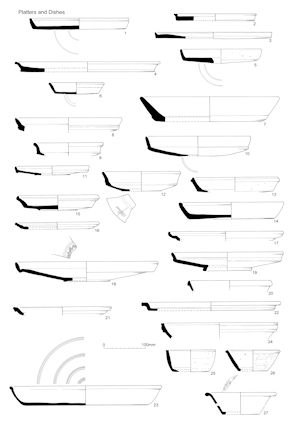
Cite this as: Compton, J. 2015 The Late Iron Age Vessel Form Typology, in M. Atkinson and S.J. Preston Heybridge: A Late Iron Age and Roman Settlement, Excavations at Elms Farm 1993-5, Internet Archaeology 40. http://dx.doi.org/10.11141/ia.40.1.compton3
This typology encompasses all Late Iron Age vessel forms found at Elms Farm that do not appear in either the Camulodunum (Hawkes and Hull 1947) or the Chelmsford (Going 1987) type series. The latter is of limited use in any case, owing to the relatively late settlement foundation date of AD 60/5 (Going 1987; Drury 1988, 125-8). Many of the seemingly new forms, however, can be paralleled elsewhere in Essex, such as at Kelvedon (Rodwell 1988), where there is attested occupation in the late 1st century BC. The study of grog-tempered ware in south-east England (Thompson 1982) was consulted, since its value lies in providing a corpus of the Late Iron Age grog-tempered pottery found previously in Essex.
Pottery that is normally considered to be of Late Iron Age date (c. 50 BC-AD 50) comprises more than a quarter of the total pottery assemblage from the excavations. The proportion of grog-tempered pottery is correspondingly high at 19% by weight of all pottery recovered. The potential of this very large assemblage to provide a well-dated vessel form typology for the Late Iron Age is high, coupled as it is with good stratigraphic sequences. For the reasons given below, the potential has not been fully realised, but the typology, as presented, constitutes a major addition to the corpus of Late Iron Age pottery types. This holds true, not just for locally made grog-tempered pottery, but for continental Late Iron Age forms as well.
At the project planning stage, the typology was intended to be a working document for use during the pottery recording programme. It was envisaged that it would incorporate all published Late Iron Age forms from Essex, including those from Camulodunum, and, supplemented by the 'new' forms from Elms Farm, constitute the basis for a comprehensive county-wide typology. In the event, several factors precluded this approach. The main difficulty encountered was the problem of residuality. Grog-tempered pottery, by itself, is not intrinsically datable and many of the forms are long-lived. It was expected that the large number of Dressel 1 amphoras would provide the dating framework, along with the Central Gaulish and Gallo-Belgic imports. As recording progressed, it became apparent that much of the pottery intended to provide this framework was residual. Coupled with this was a severe lack of securely stratified and well-dated metalwork in association. However, despite these limitations, a number of trends can be identified, and the forms presented in this Elms Farm-specific typology can be regarded as the preliminary step towards a county-wide corpus. Further research, perhaps at sites such as Kelvedon, will augment this work, especially if datable metalwork is found in association with the types here identified.
All apparently new vessel forms, regardless of date, were isolated and drawn during the pottery recording stage. The early sand-tempered forms and almost all of the new grog-tempered forms thus identified were included in the typology, whether stratified or not, although the latest context date for inclusion was set at the end of the 1st century AD. Imported new forms are also included, as, in some cases, these seem to be newly identified forms in Britain. Priority was given to forms that appear in the Key Pottery Groups, but many nominally undated contexts are stratigraphically reliable, and this has been taken into account. There are multiple occurrences of some new forms, which lends weight to their inclusion in the typology, although single examples of a form are, in the main, not excluded. The few vessels that did not lend themselves to inclusion appear, together with the pieces of Roman date, in the Intrinsics section.
The 212 vessels have been ordered into nine basic classes following the system devised by Going (1987, 13-54) for the Chelmsford typology. Within each class, the vessels are ordered chronologically as far as possible, and follow a single continuous numerical sequence. These numbers are prefixed EF for ease of identification elsewhere in the report. Context dating information is provided, and each vessel is related to its ceramic phase where possible. A concordance table of full context details, along with archive drawing numbers, is contained in the archive.

Platters are shallow vessels, usually of wide diameter, and their internal finish distinguishes them from lids, which are normally well finished on the outer surface. Few platters were recovered from contexts dated earlier than early 1st century AD; this has been noted elsewhere (Hawkes and Hull 1947, 222; Thompson 1982, 439), although there are indications that manufacture of very shallow platters might have been underway as early as the end of the 1st century BC. Grog-tempered platters rarely have substantial footrings; their presence is very often reduced to inscribed concentric circles. Footrings, when present, are normally rounded and stubby.
The majority of the identified new platter forms are in grog-tempered ware (EF1-EF17). The difficulties in cataloguing these forms encountered at Camulodunum (Hawkes and Hull 1947, 221-2) also hold true at Heybridge. There is much variation and overlap in form detail and, as few rims are alike, type-figures are difficult to select. Since grog-tempered platter forms are so prolific, it is hard to see how they can be considered direct copies of imported platters in every case. The basic form itself might imitate continental platters, but the subsequent diversity seems to be a product of the inventiveness of local potters. The methods of manufacture for continental platters and their grog-tempered equivalents might also have been completely different. It is likely that the mouldings on imported platters were produced using formers. The lack of the use of such formers in the production of grog-tempered platters might explain the seemingly freehand variations in the form of these vessels.
Five new examples of imported platters were recorded (EF18-EF22), all in micaceous terra nigra, a fabric that normally has a restricted range of form types. Their presence at Heybridge either indicates a different production site to those commonly found in Britain or, alternatively, extension of the manufacture of vessels in this fabric into the second quarter of the 1st century AD. Two further imported platters are in Pompeian-red ware (EF23-24) and these add to the range given in Peacock (1977a, fig. 3).
These have flat bases and their rims are moulded to form a bead, sometimes out-turned. They are not related to the Cam series and so may be the earliest typologically, although the dating evidence barely supports this contention. EF1 and EF4 are from contexts dated late 1st century BC to late 1st century AD; EF2 is residual in a Period 4 pit; EF3 is associated with Dressel 1 amphora sherds but is residual in a pit of mid- to late 1st century AD date.
| Number | Context | Feature | Fabric code | Cam ref. | Ceramic phase |
|---|---|---|---|---|---|
| EF1 | 11455/6 | 11463 (Group 59) | GROG | - | 1 |
| EF2 | 14521 | 14520 (Group 711) | GROG | - | - |
| EF3 | 9048 | 9034 (Group 83) | GROG | - | - |
| EF4 | 8527 | 8525 (Group 44) | GROG | - | 1 |
Most of these grog-tempered platters could be considered variants of many of the platters presented in Hawkes and Hull (1947, pl. L), in particular Cam 21 and Cam 31-33. EF16 appears to be an example of a moulded platter, perhaps Cam 23 (a copy of Cam 5), and EF17 might be a variant of Cam 29. The majority are from contexts dated early 1st century AD, but EF15 and EF16 are dated to the second quarter, and are probably mid-1st century AD types. EF14 and EF17 are not closely dated, but are grouped with EF15 and EF16 on stylistic grounds. A range of similar platters was recovered at Kelvedon (Rodwell 1988, fig. 83.120-4; fig. 92.292-4), where the moulded vessels came from mid-1st century AD contexts.
| Number | Context | Feature | Fabric code | Cam ref. | Ceramic phase |
|---|---|---|---|---|---|
| EF5 | 7268 | 7415 (Group 309 ) | GROG | Forms 21/31 | 2 |
| EF6 | 8271 | 8282 (Group 298) | GROG | 2 | |
| EF7 | 14987 | 14980 (Group 248) | GROG | Forms 32/33 | - |
| EF8 | 20031 | 20030 (Group 248) | GROG | 3 | |
| EF9 | 7151 | 7060 (Group 310) | GROG | 2 | |
| EF10 | 7151 | 7060 (Group 310) | GROG | 2 | |
| EF11 | 4027 | 4026 (Group 62) | GROG | Form 1 | 2 |
| EF12 | 7268 | 7415 (Group 309) | GROG | - | 2 |
| EF13 | 7268 | 7415 (Group 309) | GROG | 2 | |
| EF14 | 4273/4334 | 4258 (Group 62) | GROG | Forms 24/28 | - |
| EF15 | 11063 | 11062 (Group 145) | GROG | 3 | |
| EF16 | 8014 | 8026 (Group 296) | GROG | Form 23 | 3 |
| EF17 | 18239 | Layer (Group 378) | GROG | Form 29 | - |
The continental platters are from two sources, Central Gaul and Italy. Forms in Central Gaulish micaceous terra nigra (TNM) are normally restricted to just a few types, but evidence at Elms Farm, and elsewhere, indicates that the product range could be more extensive. EF18 and EF19 are variants of Cam 1; EF18 is unusual in having internal decoration in the form of a combed wavy line. EF19 is paralleled at Silchester (Timby 2000, fig. 110.159), as are EF20-22 (Timby 2000, fig. 110.161; fig. 111.163-72). Micaceous terra nigra is thought to go out of production c. AD 25 (Rigby 1989, 120), but the evidence at both Elms Farm and Silchester suggests continuation of manufacture for certain vessel types into the second quarter of the 1st century AD.
EF23 is in Campanian Pompeian-red ware (PR, Fabric 1), the standard 'black sand' fabric. The vessel rim has an external bead, which is uncommon in Britain, and, in his study of Pompeian-red ware, Greene (1979, 130) noted that the loss of this external bead occurred early in the 1st century AD. The platter was recovered from pyre-debris pit 15417, dated c. 10 BC-AD 5.
EF24 is in Central Gaulish Pompeian-red ware (PR, Fabric 3). The vessel is mica-coated externally, and the rim has a reeded collar. The full depth of the vessel is not established, and so may be deeper than a platter. The vessel was recovered from an early 1st century AD context.
| Number | Context | Feature | Fabric code | Cam ref. | Ceramic phase |
|---|---|---|---|---|---|
| EF18 | 14533 | 14533 (Group 248) | TNM | Form 1 | 3 |
| EF19 | 14533 | 14533 (Group 248) | TNM | Form 1 | 3 |
| EF20 | 7178 | 7167 (Group 313) | TNM | - | 3 |
| EF21 | 20329 | 20481 (Group 42) | TNM | - | 2 |
| EF22 | 9488 | 9496 (Group 150) | TNM | - | 3 |
| EF23 | 15416 | 15417 (Group 33) | PR | - | 2 |
| EF24 | 11379 | 11385 (Group 61) | PR | - | 2 |
Dishes (Figure 283) are a later development of platters, wherein the vessels become deeper and the diameter is correspondingly reduced. Because this is the case, the few Late Iron Age dish forms identified came from contexts dated to the second quarter of the 1st century AD. EF25-26 are variations of Cam 44 and Cam 31 in grog-tempered ware. EF27 is an unusual form in terra rubra and is not paralleled elsewhere, although there is a superficial resemblance to Cam 53. The interior of the base has rouletted decoration.
| Number | Context | Feature | Fabric code | Cam ref. | Ceramic phase |
|---|---|---|---|---|---|
| EF25 | 7268 | 7415 (Group 309) | GROG | Form 44 | 3 |
| EF26 | 11343 | 11344 (Group 59Group 59) | GROG | Form 31D/E | 2 |
| EF27 | 11306 | 11316 (Group 227) | TR | - | 2 |
Bowls (Figure 284 and Figure 285) are usually wide-mouthed vessels, with the rim diameter being greater than the depth of the vessel. Bowl size varies greatly, those with a narrow rim diameter (less than 100mm) are often termed cups, but these small vessels have been classed as bowls for the purposes of this typology. Many Late Iron Age bowl and jar types are indistinguishable from each other, and so, vessels that are not wide-mouthed have been classed as jars (see below). Forms vary from plain, bead-rimmed types (EF28-39) through to carinated, everted-rimmed vessels (EF66-73). Some bowls appear to be derived from samian f30 (EF51-52), while the everted-rimmed bowls may be copies of samian f36 (EF68-73). These samian-like bowls are from mid-1st century AD contexts, and demonstrate that the manufacture and use of grog-tempered pottery continued into the Early Roman period.
These vessels are simple in form, with plain or slightly beaded rims. Few are decorated; any decoration consisting of shallow external grooving. The type is not represented at Camulodunum but might be equivalent to Thompson's D3-1 round bowl (1982, 335). Plain-rimmed bowls do not seem to be common, but there are handmade examples at Kelvedon (Rodwell 1988, fig. 80.63; fig. 81.95; fig. 84.137). Rodwell (1988, 107) suggests that these plain bowls are derived from Middle Iron Age types. EF28-31 are coarse handmade bowls from early contexts, EF31 in particular is dated late 1st century BC. The type appears to be long lived, as plain-rimmed bowls were found in contexts of mid-1st century AD date, although, if this is solely an early form, these examples may be residual. Most of these bowls are in coarse grog-tempered fabric, but EF36 is shell-tempered and may be a Thameside product. This vessel is from a late 1st century AD context. EF37 is residual in a Period 4 feature.
| Number | Context | Feature | Fabric code | Cam ref. | Ceramic phase |
|---|---|---|---|---|---|
| EF28 | 8271 | 8282 (Group 298) | GROGC | - | 2 |
| EF29 | 6910 | Layer (Group 72) | MICW | - | - |
| EF30 | 9793 | 9792 (Group 288) | GROG | - | - |
| EF31 | 6875 | 25252 (Group 63) | MICW | - | 1 |
| EF32 | 15881 | 15880 (Group 691) | GROGC | - | 4 |
| EF33 | 14651 | 14649 (Group 248) | GROG | - | 3 |
| EF34 | 13389 | 13892 (Group 397) | GROGC | - | 4 |
| EF35 | 13388/9 | 13892 (Group 397) | GROGC | - | 4 |
| EF36 | 13639 | 13717 (Group 594) | ESH | - | - |
| EF37 | 14521 | 14520 (Group 711) | GROG | - | - |
| EF38 | 7179 | 7167 (Group 313) | GROG | - | 3 |
Many of the forms in this group are restricted to just one or two examples each, highlighting further the diversity of form exhibited by grog-tempered pottery.
EF39 and EF40 are probably equivalent to Thompson's lid-seated bowls, D3-2 to D3-4 (1982, 337-45), which are related to Cam 250-253. The bowls in Thompson, however, are mainly incurved, and the particular forms that can be paralleled with the Elms Farm examples seem to be Hertfordshire types (e.g. Thompson 1982, 337, no. 4; 344, no. 8). EF39 is from a late 1st century BC ditch fill, but EF40 is residual in a Period 3 context.
Bowls EF41 and EF42 appear to have similarities in that the rims of both are slightly inturned and have a series of grooves on the upper body. However, EF41 is handmade and comes from a late 1st century BC ditch fill, whereas EF42 is wheel-thrown and probably a later type. The rudimentary cordons on EF41 are reminiscent of the grooves and cordons on jars EF85-88, below, and this bowl may be part of the same early series. There is a parallel at Kelvedon (Rodwell 1988, fig. 81.81), confirming the late 1st century BC date for the form. Wheel-thrown EF42 has two deeply indented and clearly defined grooves, and thus is clearly a separate bowl type. No parallels have been found. The vessel comes from an early to mid-1st century AD pit.
Small bowls EF43 and EF44 are probably related to Thompson's cup forms E2-4 (1982, 389) and E1-4 (1982, 367), respectively. EF43 does not have the omphalos base defined for Thompson's E2-4, and, unfortunately, is not closely dated. EF44 differs from Thompson's E1-4 cup in that there is a cordon beneath the carination, which, on EF44, is exaggerated. The vessel comes from cremation burial 8177, dated late 1st century BC to early 1st century AD (see also EF159-160).
The small group of everted-rimmed bowls EF45-48 are probably variants of Cam 43 and Cam 44. Variations in rim detail for these two forms are shown in Hawkes and Hull (1947, fig. 48), and the bowls from Elms Farm would fit into the series. Bowls EF45-47 are from contexts dating to the first half of the 1st century AD, but EF48 is unstratified.
Bowls EF49-52 are likely variants of Cam 69, which is apparently based on samian f30 and probably a forerunner of the C12 bowl found at Chelmsford. Bowls EF49, EF51-52 are from mid- to late 1st century AD contexts, but EF50 is not closely dated.
EF53 and EF54 have much in common with Thompson's corrugated, conical bowl, D3-5 (1982, 347), although Thompson notes that the form is normally confined to Kent, or to rich burials of the 1st century BC. There is a corrugated rim from Kelvedon (Thompson 1982, fig. 51a.1490), tentatively identified by Thompson, and very similar to EF54. Unfortunately, neither of the examples from Elms Farm is closely dated.
| Number | Context | Feature | Fabric code | Cam ref. | Ceramic phase |
|---|---|---|---|---|---|
| EF39 | 7540 | 25045 (Group 5) | GROG | - | 1 |
| EF40 | 5810 | Layer (Group 398) | GROG | - | - |
| EF41 | 6957 | 25252 (Group 63) | GROG | - | 1 |
| EF42 | 7179 | 7167 (Group 313) | GROG | - | 3 |
| EF43 | 8241 | 8244 (Group 289) | GROG | - | - |
| EF44 | 8173 | 8177 (Group 84) | GROG | - | 2 |
| EF45 | 14651 | 14649 (Group 248) | GROG | Form 43/44 | 3 |
| EF46 | 19109 | 19104 (Group 47) | GROG | Form 43/44 | 2 |
| EF47 | 8016 | 8017 (Group 1309) | GROG | Form 43/44 | 3 |
| EF48 | 24015 | Unstratified (Group 8006) | GROG | Form 43/44 | - |
| EF49 | 11227 | 11228 (Group 207) | GROG | Form 69 | 2 |
| EF50 | 11145 11148 (Group 236) | GROG | Form 69 | - | |
| EF51 | 4899/4993 | Layer (Group 749) | GROG | Form 69 | - |
| EF52 | 3699 | 3701 (Group 889) | GROG | Form 69 | 4 |
| EF53 | 14948 | 14947 (Group 248) | GROG | - | - |
| EF54 | 14427 | 14426 (Group 263) | GROG | - | - |
Small bowl EF55 has a vertical rim with an internal bead and a small internal step part-way down the wall. There is no parallel for this vessel either at Camulodunum or in Thompson (1982). It was recovered from a mid-1st century AD pit. EF56 is a variant of Cam 57, although much less ornate. The plain, straight-sided cup from Elms Farm is echoed by the Hertfordshire form (Thompson 1982, 494, nos 7-8), and is of a similar date - early to mid-1st century AD. The remainder fall into two groups, essentially based on size. Bowls EF57-65 are cup-sized vessels with carination and a narrow base. The form may be based on samian f27 or Ritterling 5, although the similarity is slight. A large number of these bowls were recovered, and the illustrated examples show the differences in detail. Given the number of examples excavated, it is noteworthy that there are no parallels at Camulodunum, indicating perhaps that production of these vessels was local to Heybridge. All of the dated examples are from mid-1st century AD contexts, and some are in Roman fabrics. EF66-73 are everted-rimmed bowls, sometimes reeded, with a carinated wall beneath the rim. These are related to Cam 246, although closer parallels can be found in Thompson (1982, 483-4; type G2-3). It is probable that these flanged bowls are based on samian f36 and probable forerunners of Going's B10 dish (1987, fig. 2). EF69 and EF71-73 are in red-surfaced grog-tempered ware, which is a further indication of the samian origins for the form. The dated examples come from contexts of either early to mid-1st century AD date or mid- to late 1st century date.
| Number | Context | Feature | Fabric code | Cam ref. | Ceramic phase |
|---|---|---|---|---|---|
| EF55 | 23326 | 23399 (Group 31) | GROG | - | 3 |
| EF56 | 4525 | 4526 (Group 729) | GROG | Form 57 | 3 |
| EF57 | 9214 | 25018 (Group 764) | GRF | - | 4 |
| EF58 | 7277 | 7276 (Group 313) | GROG | - | 3 |
| EF59 | 20011 | 20010 (Group 707) | BSW | - | - |
| EF60 | 13218 | 13892 (Group 397) | GROG | - | 4 |
| EF61 | 4899 | Layer (Group 749) | GROG | - | - |
| EF62 | 13639 | 13640 (Group 594) | BSW | - | 4 |
| EF63 | 7268 | 7415 (Group 309) | GROG | - | 3 |
| EF64 | 9370 | 9218 (Group 768) | GRF | - | 4 |
| EF65 | 7150 | 7149 (Group 1348) | GROG | - | 3 |
| EF66 | 10155 | 10146 (Group 297) | GROG | Form 246 - | - |
| EF67 | 9096 | 9095 (Group 154) | GROG | Form 246 | - |
| EF68 | 4899 | Layer (Group 749) | GROG | Form 246 | - |
| EF69 | 11379 | 11385 (Group 61) | GROGRS | Form 246 | 2 |
| EF70 | 8742 | 25521 (Group 663) | GROG | Form 246 | 4 |
| EF71 | 11720 | 11723 (Group 142) | GROGRS | Form 246 | 4 |
| EF72 | 8018 | 8026 (Group 296) | GROG | Form 246 | 3 |
| EF73 | 9231 | 9230 (Group 288) | GROGRS | Form 246 | 3 |
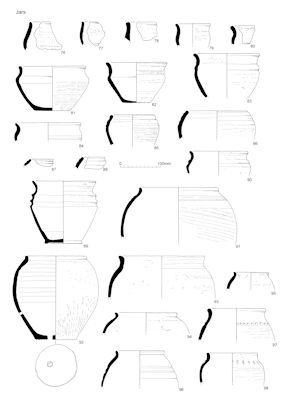
As a vessel class, mortaria are rare in Late Iron Age Britain. Both of the identified vessels are forerunners of the wall-sided Cam 191, and were probably imported, perhaps from Italy, the Rhineland or Central Gaul. Thin-sectioning shows that EF75 is unlikely to be a Colchester product. Neither has the internal trituration grits characteristic of mortaria of Roman date. The vertical rim and small bead are indicative of vessels from early in the Cam 191 series. Both vessels are from contexts dated to the first quarter of the 1st century AD.
| Number | Context | Feature | Fabric code | Cam ref. | Ceramic phase |
|---|---|---|---|---|---|
| EF74 | 15416 | 15417 (Group 33) | IBUFM | Form 191 | 2 |
| EF75 | 8262 | 8274 (Group 298) | COLBM | Form 191 | 2 |
This is the largest category and encompasses most of the coarse pottery forms whose girth is greater than the rim diameter. The jar section provides the best typological evidence, as the majority of the vessels are closely dated and from securely stratified features. The vessels are grouped by broad type and then chronologically within each type.
This section builds on the work done by Birchall (1965), Rodwell (1976) and Thompson (1982) in identifying chronological trends in the typological detail of jars. It also draws on the forms and dating of the published pottery from Little Waltham (Drury 1978) and Kelvedon (Rodwell 1988). As can be seen below, the combined results of the work on Late Iron Age pottery, especially in Essex, has aided greatly the compilation of the jar typology.
Only one pedestal vessel (EF140) was identified, although a large number of pedestal fragments were recovered. Few fragments could be linked with their parent vessels, and many of the jars here depicted may once have had pedestals. A decision was made not to include bases in the Elms Farm typology, but the dating, as put forward by Thompson (1982, 35-71) for her Type A pedestal jars, has been borne out by the contextual evidence of the excavated pedestal fragments.

With few exceptions, these jars have a basic S-shaped profile and are undecorated. Many of the forms can be paralleled with those recovered from Ditch 350 at Kelvedon (Rodwell 1988, figs 79 and 80), dated to the second half of the 1st century BC. The handmade jars, EF76-84, in particular, provide a link between the coarse pottery of Middle Iron Age date and that of the later Iron Age. EF89 and EF90 have sharp shoulder cordons, and, along with EF96, may be the antecedents of the ripple-shouldered Cam 229. These jars are probably handmade and wheel-finished, rather than fully wheel-thrown, and the cordons may demonstrate the beginnings of inventiveness on the part of the potters that characterises wheel-thrown grog-tempered pottery of all types. The stabbed decoration on the shoulders of EF97-102 is often accompanied by combing on the lower body. Parallels can be found in Thompson (1982, 289-95), where the early origin for the form is noted. EF107-108 both have irregular zigzag decoration on the shoulder, which is less common. Most of these jars come from late 1st century BC features, except for EF78, EF92, EF94-95, EF103 and EF105, which may be residual in early to mid-1st century AD contexts.
| Number | Context | Feature | Fabric code | Cam ref. | Ceramic phase |
|---|---|---|---|---|---|
| EF76 | 19145 | 25094 (Group 46) | GROG | - | 1 |
| EF77 | 19116 | 25094 (Group 46) | MICW | - | 1 |
| EF78 | 19111 | 19104 (Group 47) | MICW | - | 2 |
| EF79 | 6907 | 25252 (Group 63) | GROG | - | 1 |
| EF80 | 19116 | 25094 (Group 46) | MICW | - | 1 |
| EF81 | 8785 | 8786 (Group 48) | GROG | - | 1 |
| EF82 | 8785 | 8786 (Group 48) | GROG | - | 1 |
| EF83 | 19116 | 25094 (Group 46) | MICW | - | 1 |
| EF84 | 8519/21 | 25174 (Group 50) | MICW | - | 1 |
| EF85 | 19116 | 25094 (Group 46) | MICW | - | 1 |
| EF86 | 8785 | 8786 (Group 48) | GROG | - | 1 |
| EF87 | 8527 | 8525 (Group 44) | MICW | - | 1 |
| EF88 | 8504 | 25174 (Group 50) | GROG | - | 1 |
| EF89 | 8785 | 8786 (Group 48) | GROG | - | 1 |
| EF90 | 8241 | 8244 (Group 289) | GROG | - | - |
| EF91 | 7326 | 7322 (Group 5) | GROG | - | - |
| EF92 | 9048 | 9034 (Group 83) | GROGC | - | - |
| EF93 | 7326 | 7322 (Group 5) | GROG | - | - |
| EF94 | 7268 | 7415 (Group 309) | GROG | - | 2 |
| EF95 | 7268 | 7415 (Group 309) | GROG | - | 2 |
| EF96 | 9288 | 9297 (Group 2085) | MICW | - | - |
| EF97 | 8206 | 8208 (Group 7) | GROGC | Form 263 | 1 |
| EF98 | 6957 | 25252 (Group 63) | MICW | Form 263 | 1 |
| EF99 | 20031 | 20030 (Group 248) | GROGC | Form 263 | 3 |
| EF100 | 14341 | 14344 (Group 3041) | GROGC | Form 263 | 1 |
| EF101 | 14341 | 14344 (Group 3041) | GROGC | Form 263 | 1 |
| EF102 | 14341 | 14344 (Group 3041) | MICW | Form 263 | 1 |
| EF103 | 9585 | 9611 (Group 75) | GROG | - | 2 |
| EF104 | 6957 | 25252 (Group 63) | GROG | - | 1 |
| EF105 | 15969 | 15968 (Group 141) | GROGC | - | 3 |
| EF106 | 6875 | 25252 (Group 63) | GROG | - | 1 |
| EF107 | 6875 | 25252 (Group 63) | GROGC | - | 1 |
| EF108 | 14341 | 14344 (Group 3041) | MICW | - | 1 |
| EF109 | 18579 | 18578 (Group 17) | GROG | - | 1 |
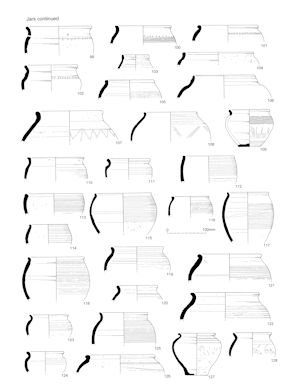
Wheel-thrown jars first appeared towards the end of the late 1st century BC. The first group of jars (EF110-128) all have rilling, some more extensively than others. EF110 and EF112 are handmade, indicating that rilling as a form of decoration was long lived. The comparable Cam 260 first appeared before the conquest, but only became common in the Claudian period (Hawkes and Hull 1947, 270). Jars with rilling on the shoulders continued in production throughout the Roman period (see Going's form G21, 'Braughing jars'). The form is more common in Hertfordshire (Thompson 1982, 274), where it occurs at Braughing in contexts of late 1st century BC date. The vessels here can be paralleled with Thompson's rilled jars C7-1 to C7-3 (1982, 273-85). It is possible that the simpler shapes are earlier, and the necked jars later, in date, but this may not be definitive. The jars from Elms Farm range in date from late 1st century BC through to mid- to late 1st century AD. EF126 and EF127 are in Roman fabrics and from mid- to late 1st century AD contexts.
EF129-133 are relatively coarse jars with bead rims, paralleled with Thompson's C1-2 (1982, 217). They were found in mid-1st century AD contexts. Decoration on the form seems to be uncommon, but EF130 has a band of stabbing along the shoulder, probably made with a quill or the stem of a straw.
EF134-137 are probably plain versions of Cam 258 and equate with Thompson's round-shouldered jars with inset below the rim, Type C4 (1982, 239), although these all have decoration on the shoulder. Only one jar (EF137) from Elms Farm is decorated, so plain jars are an addition to the range. Thompson notes that this is an eastern Kent form and normally in shell-tempered ware when it occurs in Essex (1982, 239). The Elms Farm jars are from contexts dated to the first half of the 1st century AD.
| Number | Context | Feature | Fabric code | Cam ref. | Ceramic phase |
|---|---|---|---|---|---|
| EF110 | 8785 | 8786 (Group 48) | GROG | - | 1 |
| EF111 | 7540 | 25045 (Group 5) | GROG | - | 1 |
| EF112 | 9048 | 9034 (Group 83) | GROGC | Form 260 | - |
| EF113 | 7289 | 7288 (Group 2102) | GROG | Form 260 | - |
| EF114 | 7268 | 7415 (Group 309) | GROG | Form 260 | 2 |
| EF115 | 8890 | 8889 (Group 60) | GROG | Form 260 | 1 |
| EF116 | 11343 | 11344 (Group 59) | GROGC | Form 260 | 2 |
| EF117 | 11269 | 11316 (Group 227) | GROG | Form 260 | 2 |
| EF118 | 20031 | 20030 (Group 248) | GROG | Form 260 | 3 |
| EF119 | 11329 | 11342 (Group 58) | GROGC | Form 260 | 1 |
| EF120 | 16021 | Layer (Group 481) | GROG | Form 260 | 3 |
| EF121 | 15003 | 15004 (Group 95) | GROGC | Form 260 | - |
| EF122 | 15003 | 15004 (Group 95) | GROGC | Form 260 | - |
| EF123 | 8265 | 8264 (Group 291) | GROGC | Form 260 | - |
| EF124 | 9069 | 9068 (Group 2083) | GROG | Form 260 | 3 |
| EF125 | 4334/4274 | 4258 (Group 276) | GROG | Form 260 | - |
| EF126 | 9214 | 25018 (Group 764) | STOR | Form 260 | 4 |
| EF127 | 3699 | 3701 (Group 889) | BSW | Form 260 | 4 |
| EF128 | 4052 | 4026 (Group 62) | GROGC | Form 260 | 2 |
| EF129 | 7168 | 7167 (Group 313) | GROG | - | 3 |
| EF130 | 11240 | 11258 (Group 145) | GROGC | - | 4 |
| EF131 | 9217 | 9218 (Group 768) | GROG | - | 4 |
| EF132 | 7376 | 7357 (Group 157) | GROG | - | - |
| EF133 | 8271 | 8282 (Group 298) | GROGC | - | 2 |
| EF134 | 4027 | 4026 (Group 62) | GROGC | ?Form 258 | 2 |
| EF135 | 19110 | 19104 (Group 47) | GROG | ?Form 258 | 2 |
| EF136 | 10207 | 10208 (Group 354) | GROGC | ?Form 258 | 2 |
| EF137 | 17258 | 17412 (Group 330) | GROG | ?Form 258 | 3 |
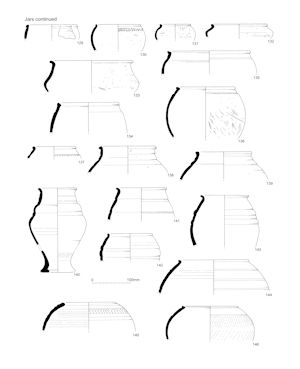
These are described by Thompson as barrel jars (1982, 191-209). All have grooves and cordons to some degree, and are bead-rimmed. EF140 has an out-turned pedestal foot and has the most prominent cordons. EF145-146 have inbent rims and are probably decorated versions of Cam 252, as shown in Thompson (1982, 343-5). These are her elaborate lidded bowls, D3-4, rather than barrel jars. Both vessels are from contexts dated to the second quarter of the 1st century AD. EF147-151 all have mid-girth cordons; EF147-148 have inturned, grooved rims reminiscent of Cam 255 rather than a bead rim. EF152-155 have much less pronounced cordons, and may perhaps be linked to EF156-164 below. EF138-144 and EF148-151 are from contexts as early as the late 1st century BC, but continue into the 1st century AD. EF152-155 date to the first half of the 1st century AD, which confirms the link with EF156-164. EF147 is residual in a Period 3 context.
| Number | Context | Feature | Fabric code | Cam ref. | Ceramic phase |
|---|---|---|---|---|---|
| EF138 | 8785 | 8786 (Group 48) | GROG | - | 1 |
| EF139 | 8785 | 8786 (Group 48) | GROG | - | 1 |
| EF140 | 11227 | 11228 (Group 207) | GROG | - | 2 |
| EF141 | 8265 | 8264 (Group 291) | GROG | - | - |
| EF142 | 14948 | 14947 (Group 248) | GROG | - | - |
| EF143 | 4334 | 4258 (Group 276) | GROG | - | - |
| EF144 | 8596 | 8594 (Group 222) | GROG | - | - |
| EF145 | 15745 | 15744 (Group 691) | GROG | Form 252 | 3 |
| EF146 | 8003 | 8026 (Group 296) | GROG | Form 252 | 3 |
| EF147 | v4200 | Unstratified (Group 3088) | GROG | Form 255 | - |
| EF148 | 4168 | 4203 (Group 275) | GROGC | Form 255 | 2 |
| EF149 | 8890 | 8889 (Group 60) | GROG | Form 249 | 1 |
| EF150 | 7186 | 7060 (Group 310) | GROG | Form 249 | 2 |
| EF151 | 9288 | 9297 (Group 2085) | GROG | Form 249 | 2 |
| EF152 | 15969 | Pit 15968 (Group 141) | GROGC | - | 3 |
| EF153 | 9610 | Pit 9611 (Group 75) | GROG | - | 2 |
| EF154 | 9610 | Pit 9611 (Group 75) | GROG | - | 2 |
| EF155 | 9043 | Pit 9084 (Group 293) | GROG | - | - |
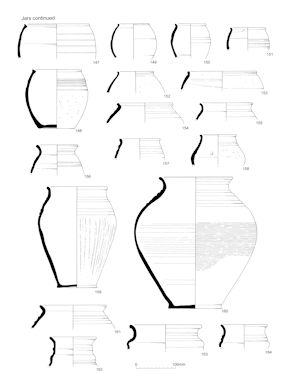
These are relatively long-lived types, but there is evidence to suggest that jars with rippled shoulders may have had a start date late in the 1st century BC, and are superseded by the cordoned jars that are so common at Camulodunum (Cam 218). The first group of jars with rippled shoulders (EF156-164) is paralleled with Cam 229 and Thompson's B2 jars (1982, 117-37). These jars also show some of the wide variation in neck detail for the form. Unfortunately, most of the jars from Elms Farm provide little dating evidence; EF159 and EF160 are from cremation burial 8177, dated late 1st century BC to early 1st century AD, otherwise the jars are not closely dated. EF165-169 resemble Cam 218 (Thompson's B3 jars). Three jars (EF166-168) have burnished lattice decoration on the lower body, a feature which is lacking on Cam 218 itself, but this may not have any significance. These jars continue into the mid-1st century AD, as does Cam 218, which is, in turn, the forerunner of Going's G16 jar at Chelmsford (1987, 24), dated mid- to late 1st century AD.
| Number | Context | Feature | Fabric code | Cam ref. | Ceramic phase |
|---|---|---|---|---|---|
| EF156 | 3556 | 3557 (Group 915) | GROG | Form 229 | - |
| EF157 | 8146 | 8147 (Group 4) | GROG | Form 229 | - |
| EF158 | 24137 | 24134 (Group 232) | GROG | Form 229 | - |
| EF159 | 8175 | 8177 (Group 84) | GROG | Form 229 | 2 |
| EF160 | 8169 | 8177 (Group 84) | GROG | Form 229 | 2 |
| EF161 | 15003 | 15004 (Group 95) | GROG | Form 229 | - |
| EF162 | 14948 | 14947 (Group 248) | GROG | Form 229 | - |
| EF163 | 12240 | 12288 (Group 335) | GROG | Form 229 | - |
| EF164 | 4334 | 4258 (Group 276) | GROG | Form 229 | - |
| EF165 | 24179 | 24181 (Group 246) | GROG | Form 218 | 3 |
| EF166 | 4113/4523 | 4130 (Group 62) | GROG | Form 218 | 2 |
| EF167 | 7654 | 7655 (Group 3078) | GROG | Form 218 | - |
| EF168 | 24336 | 24335 (Group 1206) | GROG | Form 218 | - |
| EF169 | 7152 | 7118 (Group 938) | BSW | Form 218 | - |
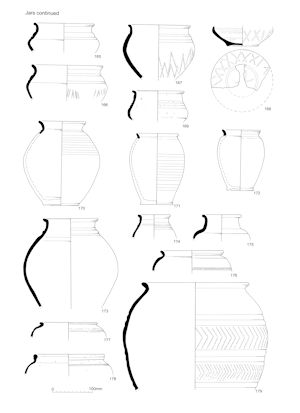
These vessels do not form a cohesive group, although all but EF179 are relatively plain. EF170-173 are paralleled with Thompson's B5-2 jars (1982, 196-7). EF170-172 are from cremation burial 2379, dated late 1st century BC to early 1st century AD and EF171-172 are similar to the 'early jars' found in the Lexden cemetery, Colchester (Hawkes and Crummy 1995, 164-9).
EF174-175 are paralleled with Cam forms; EF175 is probably from a pedestal vessel similar to Thompson's Type A5 (1982, 65-9). Both vessels come from contexts dating to the first half of the 1st century AD. EF176-178 have everted rims with external detail and shallow bands of grooving on the shoulder. They are from contexts of mid-1st century AD date. There are similarities with Going's form G8 (1987, 23) of Claudio-Neronian date. EF179 is a vessel of storage jar proportions but is in fine grog-tempered ware and has bands of chevron decoration between cordons. This might represent a 'one-off' rather than a separate type. It was recovered from a context dated to the second quarter of the 1st century AD.
| Number | Context | Feature | Fabric code | Cam ref. | Ceramic phase |
|---|---|---|---|---|---|
| EF170 | 2483 | 2379 (Group 315) | GROG | - | 2 |
| EF171 | 2482 | 2379 (Group 315) | GROG | - | 2 |
| EF172 | 2481 | 2379 (Group 315) | GROGRF | - | 2 |
| EF173 | 4168 | 4203 (Group 275) | GROG | - | - |
| EF174 | 24179 | 24181 (Group 246) | GROG | Form 234 | 2 |
| EF175 | 10205 | 10206 (Group 354) | GROG | Form 204 | 3 |
| EF176 | 3699 | 3701 (Group 889) | GROGC | - | 4 |
| EF177 | 7661 | Layer (Group 383) | GROG | - | - |
| EF178 | 9214 | 25018 (Group 764) | STOR | - | 4 |
| EF179 | 8014/8 | 8026 (Group 296) | GROG | - | 3 |
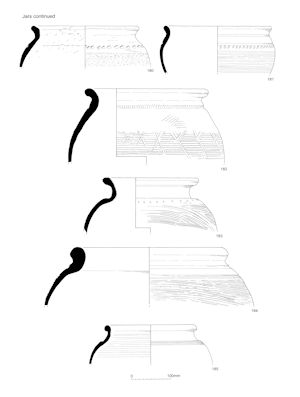
All six are very large jars made in coarse grog-tempered fabric, most with combing over the lower body. EF180-181 are from late 1st century BC contexts and represent the storage jar equivalent of EF97-102 above. EF182-185 are additions to the range of storage jars in Thompson (1982, 257-67, type C6-1). Essentially, these are not closely datable but at Elms Farm mainly come from contexts dated to the first half of the 1st century AD.
| Number | Context | Feature | Fabric code | Cam ref. | Ceramic phase |
|---|---|---|---|---|---|
| EF180 | 8206 | 8208 (Group 7) | GROGC | - | 1 |
| EF181 | 14341 | 14344 (Group 3041) | GROGC | - | 1 |
| EF182 | 24179 | 24181 (Group 246) | GROGC | - | 3 |
| EF183 | 13387 | 13892 (Group 397) | GROGC | - | 4 |
| EF184 | 7289 | 7288 (Group 2102) | GROGC | - | - |
| EF185 | 11755 | 11774 (Group 54) | GROGC | - | 1 |
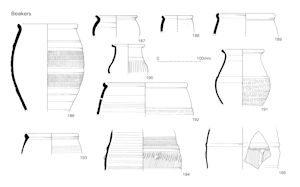
Along with jars, these vessels have a girth greater than the rim diameter, but are normally classed as beakers when made in Gallo-Belgic fabrics or are themselves copies of these beakers. The division is purely arbitrary, and as a consequence few vessels were identified as new beaker types. Six are in local fabrics and four are continental in origin.
EF186 is in red-surfaced grog-tempered ware and is related to Cam 116. The external surface is highly burnished between the zones of decoration, and it is possible that the vessel is imported rather than locally made. EF187 is also in red-surfaced grog-tempered ware and is a copy of the lid-seated Cam 102. These copies are common in Hertfordshire (Thompson 1982, 111; Type B1-6), but only occasionally occur elsewhere. EF188 and EF189 are in standard grog-tempered fabric, but are small, perhaps even miniature, versions of the butt beaker Cam 115. Both have inturned rim edges, and not enough survives to determine whether either was decorated.
EF190-191 are beakers in Silty Ware, as identified by Rigby (1989, 195) at King Harry Lane, Verulamium. Thin-sectioning of the Elms Farm pottery has indicated that the wares from both sites are probably from the same source. The King Harry Lane beakers were copies of the north Gaulish beaker, Cam 113, and of mid-1st century AD date. This also seems to be the case for EF190-191.
| Number | Context | Feature | Fabric code | Cam ref. | Ceramic phase |
|---|---|---|---|---|---|
| EF186 | 4432/4457 | 4517 (Group 62) | GROGRF | Form 116 | 2 |
| EF187 | 3556 | 3557 (Group 915) | GROGRS | Form 102 | - |
| EF188 | 7178 | 7167 (Group 313) | GROG | Form 115 | 3 |
| EF189 | 11301 | 11316 (Group 227) | GROG | Form 115 | 2 |
| EF190 | 6794 | Layer (Group 195) | SILT | Form 113 | 4 |
| EF191 | 24135 | 24134 (Group 232) | SILT | Form 113 | - |
EF192 is a newly identified form in micaceous terra nigra and adds to the product range. Micaceous beakers were found at Silchester (Timby 2000, fig. 110.138, 141-4) but seem to be in a non-standard micaceous terra nigra fabric. The Elms Farm beaker comes from an early to mid-1st century pit fill.
EF193 is an imported beaker with a rouletted decoration in the form of rows of tiny squares. The rim has an internal overhang similar to Cam 113 and also has an external cordon between the rim and the neck. The fabric has been identified as terra rubra, as the surfaces are fired to buff-orange, and there is a red slip over the rim and in the hollows of the rouletting. The fabric is very similar to that of EF194 and might be from the same source; this is likely to be northern Gaul for both.
EF194-195 are fragments from two different types of bossed beaker (cf. Holwerda 1941, no. 104). As noted, EF194 is in a similar fabric to EF193, with an external red slip. There is a zone of oblique rouletting between cordons, and applied over part of the rouletting is a small round boss. The fabric of both EF193 and EF194 is fine and sandy, buff to grey in colour, with occasional mica and many small black inclusions. This is unlike either true terra rubra, or the north Gaulish white ware of Cam 113, but a continental origin is still preferred. Bossed beakers are uncommon in Britain, but have been found at Silchester (Timby 2000, fig. 135.710) and Verulamium (Frere 1972, fig. 107; Stead and Rigby 1989, fig. 56.1A5). An example has been found previously in Essex, at Sandford Quarry, Hatfield Peverel (Martin 1996a, fig. 4.1). The Elms Farm beaker is dated late 1st century BC to early 1st century AD.
EF195 is in the conventional north Gaulish white fine sandy fabric used for Cam 113 beakers. The sherd has a zone of rouletting between cordons and a vertical barbotine line applied over part of the rouletting. It is possible that the line may have originated as a round boss similar to EF194, but appears to have been a deliberately made line. A parallel for this decorative variant comes from Colchester (Hawkes and Crummy 1995, fig. 6.10.6), although this beaker is thought to be locally made and of Augusto-Tiberian date (Rigby 1995, 119). The Elms Farm sherd comes from a late 1st century BC to early 1st century AD context.
| Number | Context | Feature | Fabric code | Cam ref. | Ceramic phase |
|---|---|---|---|---|---|
| EF192 | 7168/78 | 7167 (Group 313) | TNM | - | 3 |
| EF193 | 9625 | 9646 (Group 151) | TR | - | 4 |
| EF194 | 11452 | 11450 (Group 61) | ?TR | - | 2 |
| EF195 | 19109/11 | 19104 (Group 47) | NGWFS | - | 2 |
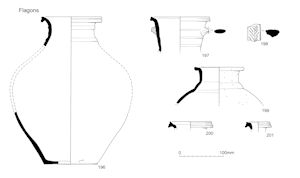
Flagons are a relatively rare Late Iron Age form in Essex, and usually originate from continental sources, rather than being locally made. Some grog-tempered copies were produced, however, mainly copying Cam 161 and Cam 165 double-handled flagons, and EF196-197 are undoubtedly locally made variants of these forms. EF196 was recovered from pyre-debris pit 15417, dated c. 10 BC-AD 5. The decorated handle (EF198) was residual in a Period 5 context but the vessel it came from may have been an attempted copy of Cam 166 in red-surfaced grog-tempered ware. EF199 is in a pale buff fabric and might be from an imported vessel. It has been classed as a flagon on fabric grounds, but there is no trace of a handle. It was recovered from a mid- to late 1st century AD context.
Central Gaulish flagons, EF200-201, have reeded rims, only two examples of which have previously been noted in Britain (Rigby and Freestone 1986, 9). The first (Rigby and Freestone 1986, Type F1) is from the Welwyn Garden City burial (Stead 1967) and the second (Rigby and Freestone 1986, Type F2) from the Dorton mirror burial (Farley 1983). A third, but slightly different, flagon has been found at Silchester (Timby 2000, fig. 110.146); this has two frilled cordons in addition to the reeding. The rims from Elms Farm are of smaller diameter than these published examples, and may represent the reeded equivalent of Rigby and Freestone's Type F3a flagon (1986, fig. 1). EF200 is from a late 1st century BC context, but EF201 is not closely dated.
| Number | Context | Feature | Fabric code | Cam ref. | Ceramic phase |
|---|---|---|---|---|---|
| EF196 | 15418 | 15417 (Group 33) | GROG | Form 161/165 | 2 |
| EF197 | 20031 | 20030 (Group 248) | GROG | Form 161/165 | 3 |
| EF198 | 6318 | 6317 (Group 577) | GROGRF | - | - |
| EF199 | 18238 | 18258 (Group 3013) | BUF | ?Form 167 | - |
| EF200 | 9541 | 9540 (Group 288) | CGFCS | - | 1 |
| EF201 | 7208 | 7209 (Group 2104) | CGFCS | - | - |
Lids are difficult to categorise and consequently are unlikely to impart much typological information. The lids at Camulodunum (Hawkes and Hull 1947, pl. LXXXV) were not given separate form codes. It was noted (1947, 267, 273) that large and elaborate lids with hollow knobs (especially Cam 252 and Cam 253) might be early in the series, and that shallow, conical lids with flat grips were more Roman in character. This trend is borne out in Thompson (1982, 535-57), but may not be a hard-and-fast rule. The lids from Elms Farm add little except to demonstrate the variety within the form. Decorated lids, such as EF203 and EF206, are uncommon, as any decoration seems to be normally limited to grooves and cordons. Purpose-made lids do not seem to occur in late 1st century BC contexts, and those from Elms Farm, appropriately, are from contexts dating to the first quarter of the 1st century AD. EF202 is from cremation burial 2379 (see also EF170-172), although it did not form a pair with any of the jars it accompanied. Unfortunately, EF203, EF204 and EF206 were all unstratified.
| Number | Context | Feature | Fabric code | Cam ref. | Ceramic phase |
|---|---|---|---|---|---|
| EF202 | 2484 | 2379 (Group 315) | GROG | - | 2 |
| EF203 | 14609 | Unstratified (Group 8005) | GROG | - | - |
| EF204 | 17004 | Unstratified (Group 8005) | GROG | - | - |
| EF205 | 4363 | 4285 (Group 62) | GROGC | - | 2 |
| EF206 | 8000 | Unstratified (Group 8013) | GROG | - | - |
| EF207 | 8262 | 8274 (Group 298) | GROG | - | 2 |
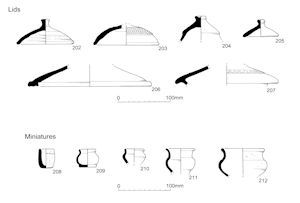
Miniatures can be defined as small-scale versions of normal-sized vessels, although any very small vessel could be classified as a miniature. Few of the small pots from Elms Farm are likely to be true miniatures, however.
EF208 is handmade and could be a Middle Iron Age vessel residual in a Late Iron Age feature.
EF209 is neatly made in grog-tempered fabric. It seems to be a purpose-made small pot instead of a true miniature. It is unfortunately unstratified.
EF210-211 are incomplete and it is possible that these are the cups from triple vases. The first is unstratified but EF211 comes from a mid- to late 1st century AD context.
EF212 appears to be a miniature version of Cam 221, although similar vessels are described as cups by Thompson (1982, 391, Type E3-1). The Elms Farm vessel is dated to the first half of the 1st century AD. The cups in Thompson seem to have a broad date range. The evidence from Elms Farm also suggests that miniature vessels have little use as chronological indicators, although, if they are true miniatures, the date applied to the full-sized version should be presumed.
| Number | Context | Feature | Fabric code | Cam ref. | Ceramic phase |
|---|---|---|---|---|---|
| EF208 | 11227 | Pit 11228 (Group 207) | MICW | - | 2 |
| EF209 | 3500 | Unstratified (Group 8011) | GROG | - | - |
| EF210 | 6609 | Unstratified (Group 8001) | BSW | - | - |
| EF211 | 3699 | Pit 3701 (Group 889) | GROG | - | 4 |
| EF212 | 7267 | Pit 7266 (Group 2114) | GROG | Form 221 | 3 |
In common with the work done on Late Iron Age pottery at Camulodunum (Hawkes and Hull 1947), the twin problems of residuality and longevity of pottery types were encountered with the Elms Farm assemblage. The apparent long life of some forms might be masked by residuality; see, for instance, the description of the plain-rimmed bowl types EF28-38. Coupled with these problems is the diversity of form exhibited by vessels in grog-tempered ware. Novelty in the use of the wheel in the early years seems to have led inherently to experimentation and inventiveness by local potters. Many highly decorative or intricate forms might thus be 'one-offs' rather than a separately defined sub-type.
The good stratigraphic sequences at Elms Farm have helped to define and strengthen the chronological trends established by Birchall (1965), Rodwell (1976) and Drury (1978). There does appear to be a short transition between handmade Middle Iron Age pottery and the later wheel-thrown grog-tempered Late Iron Age types. Some grog-tempered forms can be shown to have earlier origins than others, while many other forms were plainly introduced prior to, or at, the conquest of AD 43 (e.g. EF57-65). Many of these pottery trends fall into broad groups rather than closely defined types, with attendant dating implications. Grog-tempered pottery is, by its nature, unlikely ever to be a definitive pottery-dating tool, except in the broadest terms. Further work on similar well-stratified pottery assemblages will help to refine some dating, but sites that are occupied over a long time-span will probably add further problems of a similar nature to those encountered at both Camulodunum and Heybridge.
Other pottery assemblages with much potential to augment and enhance a county-wide typology are those from Kelvedon (unpublished) and the Airport Catering Site, Stansted (Going 2004). The ACS site, in particular, meets the criterion of having early occupation (c. 60-20 BC) combined with little later disturbance. Work to integrate the Middle to Late Iron Age forms from Stansted with the typology presented here would provide a substantial addition to the transitional examples from Elms Farm. At the later end of the date range, the pottery from Kelvedon would enhance the typology for the period spanning the early to mid-1st century AD.
Finally, it should be noted that a number of forms seem to have Hertfordshire parallels, for instance EF39 and EF40, EF110, EF112 and EF147. These forms are certainly not attested at Camulodunum. The reasons are not immediately evident, and may be an indication of the early start date for the settlement at Heybridge. This point is taken up in the pottery synthesis in Volume 1 (Atkinson and Preston 2015).
Very few vessels are included here, since most of the 'new' forms of Late Iron Age date constitute the form typology, above. The Cam 102 beakers (Figure 295, nos 4-5) complement the range illustrated in the key groups and the slipped Cam 113 (Figure 295, no. 6) is contrasted with the Silty Ware beakers that appear in the typology. D.F. Williams (pers. comm.) confirms that this vessel is from a source other than that for the Silty Ware examples, and both the fineness of the fabric and the form indicate a continental origin for this beaker.
| No. | Context | Feature | Fabric code | Form |
|---|---|---|---|---|
| 1 | 14510/7148 | Layer/7146 (Group 308) | TRCG | Platter Cam 1 |
| 2 | 4200 | Layer (Group 3088) | TRCG | Dish |
| 3 | 4000 | Unstratified (Group 8021) | GROG | Jar with boss and stabbed decoration |
| 4 | 10207 | 10208 (Group 354) | CGMIC | Beaker Cam 102 |
| 5 | 3556 | 3557 (Group 915) | CGMIC | Beaker Cam 102 |
| 6 | 13389 | 13219 (Group 3024) | NGWF | Beaker Cam 113 with white slip |
| 7 | 8006 | 8001 (Group 76) | THORN | Thorn beaker |
| 8 | 11329 | 11342 (Group 58) | THORN | Thorn beaker sherd |
| 9 | 16040 | 16046 (Group 194) | GROG | Sherd with possible handle springing |
| 10 | 24128 | Unstratified (Group 8006) | ESH | Cauldron |
| 11 | 19143 | 19142 (Group 216) | STOR | Cauldron |
| 12 | 9797 | 9798 (Group 3) | GROGC | ?Tripod foot |
| 13 | 9110 | 9111 (Group 293) | GROGC | Tripod foot |
| 14 | 13422 | 13424 (Group 175) | GROG | Stamp-decorated body sherd |
This section presents 'new' forms, intrinsically interesting pieces, and oddities. So-called new forms are those unparalleled at Chelmsford or Colchester and so cannot be given standard typological references. Most of these were produced locally in coarse reduced wares. Other new forms are in wares sourced from further afield. Typological references for these are likely to exist in type series relating to their given regions. Such pieces are, however, rare at Heybridge and central Essex and are notable for this reason. Pottery of intrinsic interest has also been included here. Such pieces may be variations of more conventional types, or may be unusual in terms of decoration or function. Finally, the ceramic oddities, whose publication might draw out parallels leading to greater functional certainty, have also been selected. The pottery is grouped and placed into vessel class order. The pieces are arranged chronologically within each class, based on stratigraphy and ceramic dating. Undated and unstratified sherds are placed at the end of each class.
| No. | Context | Feature | Fabric code | Form |
|---|---|---|---|---|
| 1 | 4794 | Layer (Group 759) | BSW | Straight-sided dish |
| 2 | 16333 | 16338 (Group 584) | BSW | Handled dish (fish dish) |
| 3 | 10000 | 10062 (Group 811) | GRS | Dish with internal wavy line decoration |
| 4 | 6118 | Layer (Group 573) | GRS | Flanged dish (variant) |
| 5 | 6025 | Layer (Group 573) | BSW | Flanged dish (variant) |

| No. | Context | Feature | Fabric code | Form |
|---|---|---|---|---|
| 6 | 15555 | 15993 (Group 691) | BSW | Carinated bowl |
| 7 | 15686 | 15993 (Group 691) | MWSRF | Bowl with stamped decoration |
| 8 | 9497 | 9496 (Group 150) | GRF | Bowl with row of prominent bosses |
| 9 | 20207 | 20213 (Group 88) | VRW | Bowl with bent-over rim |
| 10 | 9497 | 9496 (Group 150) | COLB | Flanged bowl with applied spout |
| 11 | 14865 | 14841 (Group 263) | BSW | Bowl, rim has internal overhang |
| 12 | 7574 | 7573 (Group 389) | BSW | Everted-rimmed bowl |
| 13 | 9879 | 9421 (Group 772) | BSW | Flat-rimmed bowl |
| 14 | 15862 | 24456 (Group 701) | NKO | Bowl with narrow cordon under rim |
| 15 | 13825 | 13771 (Group 594) | BSW | Bowl with pronounced vertical body ribbing |
| 16 | 11354 | 11346 (Group 3081) | BSW | Bowl with panel of oblique line burnishing |
| 17 | 4470 | 4426 (Group 739) | MSR | Flanged bowl with painted decoration |
| 18 | 5458 | Layer (Group 414) | HAX | Two-handled bowl, imitating metal original |
| 19 | 10262 | 10271 (Group 829) | MIC | Patera copy, all-over mica-dusting |
| 20 | 6589 | 6590 (Group 578) | NVC | Shallow bowl with band of internal rouletting |
| 21 | 4725 | 4733 (Group 729) | GRS | Everted-rimmed bowl with shallow grooves on rim |
| 22 | 4844 | 4913 (Group 4016) | NKG | Bowl, possibly related to Monaghan 4H1 |
| 23 | 6742 | Layer (Group 586) | GRS | Bowl with double-grooved rim |
| 24 | 7453 | 7454 (Group 1349) | STOR | C16-type bowl in storage jar fabric |
| 25 | 21746 | 21745 (Group 5008) | MWSRF | Tazza-bowl with incised decoration |
| 26 | 16333 | 16338 (Group 584) | BSW | Bowl with band of burnished line decoration under rim and stabbing beneath |
| 27 | 10516 | 10518 (Group 822) | GRF | Bowl with RSX dimples |
| 28 | 16230 | 16231 (Group 584) | GRS | Bowl with multiple cordons |
| 29 | 10516 | 10518 (Group 822) | HAX | Bowl with incised oblique line decoration |
| 30 | 10662 | 10663 (Group 838) | HAX | Bowl with raised decoration along inner rim |
| 31 | 10516 | 10518 (Group 822) | NVC | Bead-rimmed bowl or dish |
| 32 | 5148 | Layer (Group 457) | NVP | Bowl with decorated rim and bands of red slip |
| 33 | 10378 | 25027 (Group 838) | RET | Bowl with cordon under flat rim |
| 34 | 8737 | 8736 (Group 902) | STOR | Large bowl in storage jar fabric |
| 35 | 14204 | 14203 (Group 720) | EASTA | Bowl with panels of ring-stamp decoration |
| 36 | 4187 | 4128 (Group 744) | CEP | Inbent flange from a bowl |
| 37 | 12206 | Unstratified (Group 8010) | MEK | Bowl with thickened, inbent rim |
| 38 | 8000 | Unstratified (Group 8013) | GRF | Bowl with furrowed rim |
| 39 | 1100 | 0 Unstratified (Group 8022) | EASTA | Decorated body sherd |
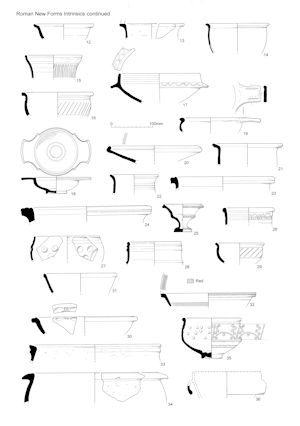
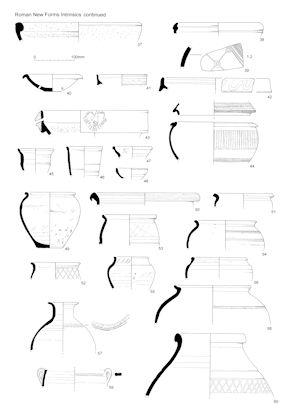
| No. | Context | Feature | Fabric code | Form |
|---|---|---|---|---|
| 40 | 24003 | 24004 (Group 712) | COLBM | Mortarium drilled for repair, heavily worn interior |
| 41 | 9008 | 9007 (Group 783) | COLBM | Wall-sided mortarium |
| 42 | 15862 | 24456 (Group 701) | MHM | Mancetter-Hartshill mortarium |
| 43 | 15224 | 15223 (Group 473) | HAXM | Wall-sided mortarium with 'bat' spout |
| No. | Context | Feature | Fabric code | Form |
|---|---|---|---|---|
| 44 | 8502/05 | 8513 (Group 678) | GRF | Decorated bowl-jar, E1 type |
| 44 | 8662 | 25097 (Group 49) | GRF | Matching lid |
| No. | Context | Feature | Fabric code | Form |
|---|---|---|---|---|
| 45 | 9287 | 25026 (Group 766) | BSW | Cup-sized vessel with external mouldings |
| 46 | 4758 | 4733 (Group 729) | MWSRF | Cup with shallow external cordons |
| 47 | 15862 | 24456 (Group 701) | NKG | Cup, probably Monaghan 6C1 |
| 48 | 19150 | 19149 (Group 658) | BSW | Carinated cup, copying samian f27 |
| No. | Context | Feature | Fabric code | Form |
|---|---|---|---|---|
| 49 | 18229/18216 | 13883 (Group 595) | GRF | Necked jar |
| 50 | 15881 | 15880 (Group 691) | BSW | Large jar with hooked rim |
| 51 | 6660 | 6646 (Group 379) | GRS | Jar with knife-trimmed rim |
| 52 | 13825 | 13771 (Group 594) | BSW | Jar with burnished lattice under rim |
| 53 | 13825 | 13771 (Group 594) | BSW | Jar with decorated shoulder and mid-body constriction |
| 54 | 13681 | 13640 (Group 594) | BSW | Jar with bands of rilling, variant of Cam 260 |
| 55 | 13692 | 13717 (Group 594) | BSW | Jar with upright rim |
| 56 | 15803 | 15757 (Group 900) | GRS | Jar with inset below thickened rim |
| 57 | 13681 | 13640 (Group 594) | GRS | Flask with decorated shoulder |
| 58 | 18238 | 18258 (Group 3013) | GRS | Lid-seated jar with row of v-shaped stabbing beneath a groove |
| 59 | 13813 | 18697 (Group 613) | BUF | Handled jar, ?honey jar |
| 60 | 4794 | Hearth (Group 759) | GRS | Large jar with lattice panel on shoulder |
| 61 | 14634 | 14632 (Group 722) | BSW | Large jar with single band of wavy-line combing on shoulder |
| 62 | 5709 | Layer (Group 600) | BSW | Jar with band of zigzag decoration between cordons |
| 63 | 16262 | 16263 (Group 566) | BSW | Large jar with lid-seated rim |
| 64 | 7506 | Layer (Group 873) | STOR | Narrow-necked jar in storage jar fabric |
| 65 | 5214 | 5209 (Group 442) | HAR | Large jar with stabbing along narrow shoulder cordon beneath inset |
| 66 | 7086 | 25111 (Group 875) | RED | Jar with frilled edge to rim and stabbing along narrow neck cordon |
| 67 | 8502 | 8513 (Group 678) | LSH | G27-type jar with grooved rim |
| 68 | 16182 | 16197 (Group 567) | ALH | Jar with grooved rim and shoulder, both with band of white slip |
| 69 | 5159 | Layer (Group 457) | BSW | Body sherd with moulded lion decoration |
| 70 | 3631 | 3632 (Group 3060) | GRS | Large jar with decorated panel below a shoulder groove |
| 71 | 23002 | Unstratified (Group 8007) | HAX | Jar with incised oblique line decoration inside rim |
| 72 | 2100 | Unstratified (Group 8011) | GRS | G26-type jar with row of incised lines on edge of rim and frilled cordon beneath |
| 73 | 2100 | Unstratified (Group 8011) | GRS | G26-type jar with row of incised lines on edge of rim and frilled cordon beneath |
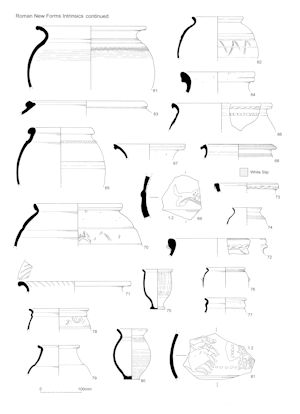
| No. | Context | Feature | Fabric code | Form |
|---|---|---|---|---|
| 74 | 17255 | 17198 (Group 331) | BLEGG | Beaker with prominent shoulder cordon decorated with fine incised lines |
| 75 | 18237 | 13883 (Group 595) | BSW | Beaker with burnished exterior and panels of tiny incised squares |
| 76 | 20180 | 20174 (Group 707) | CGCC | Beaker with three grooves under rim and handle scar (may have had barbotine decoration) |
| 77 | 13825 | 13771 (Group 594) | GRS | Beaker, as Monaghan 4J1 |
| 78 | 7206 | 7207 (Group 853) | NKG | Beaker, Monaghan 4J1 with crude incised decoration under cordon |
| 79 | 4242 | 4241 (Group 739) | BSW | Beaker with highly burnished exterior |
| 80 | 7535 | 7766 (Group 856) | GRF | H6, plain version |
| 81 | 4692 | 4695 (Group 1161) | COLC | Body sherd with barbotine chariot scene |
| 82 | 7115 | 7114 (Group 885) | GRF | Beaker with upright rim |
| 83 | 10001 | 10018 (Group 837) | UCC | Beaker with fine, oblique, barbotine line decoration |
| 84 | 6025 | Layer (Group 573) | GRS | Globular beaker with mid-body groove |
| 85 | 5229 | 5232 (Group 427) | GRF | Beaker with neck cordon and narrow vertical body indents |
| 86 | 18639 | 18640 (Group 3030) | GRS | Globular beaker with upright rim |
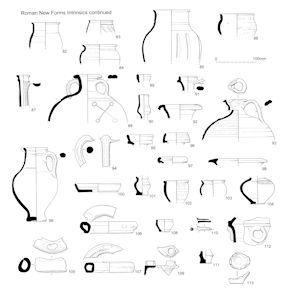
| No. | Context | Feature | Fabric code | Form |
|---|---|---|---|---|
| 87 | 5907 | Layer (Group 601) | GRF | Long-necked flagon with vertical ribbing |
| 88 | 4152 | 4137 (Group 756) | HAX | Two-handled flagon, J8, with white-painted decoration |
| 89 | 10039 | 10038 (Group 810) | GRS | Flagon with deep groove under rim |
| 90 | 5893 | 25070 (Group 422) | NVC | Flagon neck with bulge under narrow cordon |
| 91 | 11001 | 11002 (Group 1249) | GRF | Flagon with prominent collar |
| 92 | 13568 | Layer (Group 600) | MWSRS | Flagon with hooked and grooved rim |
| 93 | 24006 | Layer (Group 4026) | COLB | Flagon similar to Cam 157 |
| 94 | 6874 | 6873 (Group 546) | UCC | Flagon handle, possibly from vessel imitating metal original |
| 95 | 7086 | 25111 (Group 875) | COLB | Flagon similar to Cam 141 |
| 96 | 8802 | 8801 (Group 678) | HAX | Flagon similar to Cam 365 |
| 97 | 15233 | 15232 (Group 471) | HAX | Flagon with inbent rim, as Cam 355/6 |
| 98 | 19048 | 19047 (Group 678) | HAX | Large flat-rimmed flagon neck, probably from two-handled vessel |
| 99 | 10361 | 25027 (Group 838) | NVC | Complete plain flagon similar to Howe et al. 1980, NV63 |
| No. | Context | Feature | Fabric code | Form |
|---|---|---|---|---|
| 100 | 4880 | 4913 (Group 4016) | HAB | Miniature B1 dish |
| 101 | 6150 | 6149 (Group 577) | GRS | Possible candlestick |
| 102 | 15810 | 15811 (Group 696) | GRS | Miniature E2/G5 |
| 103 | 14022 | 14098 (Group 4019) | BSW | Miniature G3 |
| 104 | 6258 | Layer (Group 859) | BSW | Miniature G39 |
| No. | Context | Feature | Fabric code | Form |
|---|---|---|---|---|
| 105 | 416 | 418 (Group 890) | GRS | Triple vase ring |
| 106 | 7709 | Layer (Group 1000) | BSW | Triple vase ring |
| 107 | 7000 | Unstratified (Group 8015) | GRF | Triple vase ring |
| 108 | 16182 | 16197 (Group 567) | GRF | Triple vase cup |
| 109 | 4844 | 4913 (Group 4016) | COLB | Costrel |
| 110 | 11597 | 11423 (Group 693) | BSW | Feeding bottle spout |
| 111 | 10539 | 10538 (Group 838) | GRS | Candlestick? |
| 112 | 4000 | Unstratified (Group 8021) | GRS | Body sherd with skeuomorphic handle |
| 113 | 4000 | Unstratified (Group 8021) | GRF | Base sherd, trimmed to form lamp/scoop |
Internet Archaeology is an open access journal based in the Department of Archaeology, University of York. Except where otherwise noted, content from this work may be used under the terms of the Creative Commons Attribution 3.0 (CC BY) Unported licence, which permits unrestricted use, distribution, and reproduction in any medium, provided that attribution to the author(s), the title of the work, the Internet Archaeology journal and the relevant URL/DOI are given.
Terms and Conditions | Legal Statements | Privacy Policy | Cookies Policy | Citing Internet Archaeology
Internet Archaeology content is preserved for the long term with the Archaeology Data Service. Help sustain and support open access publication by donating to our Open Access Archaeology Fund.